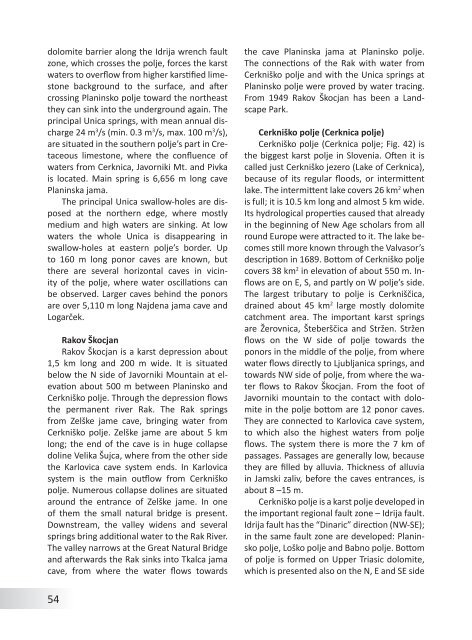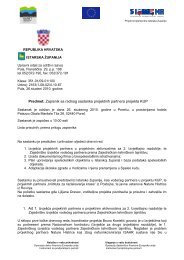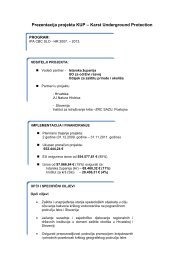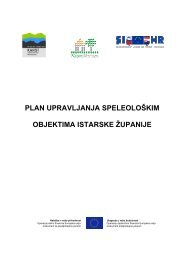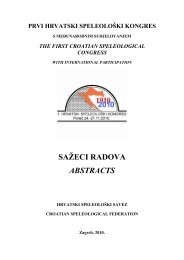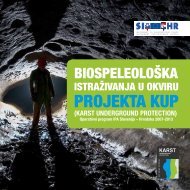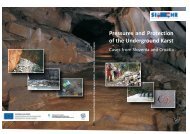Case Studies from the Dinaric Karst of Slovenia
Case Studies from the Dinaric Karst of Slovenia
Case Studies from the Dinaric Karst of Slovenia
You also want an ePaper? Increase the reach of your titles
YUMPU automatically turns print PDFs into web optimized ePapers that Google loves.
dolomite barrier along <strong>the</strong> Idrija wrench faultzone, which crosses <strong>the</strong> polje, forces <strong>the</strong> karstwaters to overflow <strong>from</strong> higher karstified limestonebackground to <strong>the</strong> surface, and aftercrossing Planinsko polje toward <strong>the</strong> nor<strong>the</strong>ast<strong>the</strong>y can sink into <strong>the</strong> underground again. Theprincipal Unica springs, with mean annual discharge24 m 3 /s (min. 0.3 m 3 /s, max. 100 m 3 /s),are situated in <strong>the</strong> sou<strong>the</strong>rn polje’s part in Cretaceouslimestone, where <strong>the</strong> confluence <strong>of</strong>waters <strong>from</strong> Cerknica, Javorniki Mt. and Pivkais located. Main spring is 6,656 m long cavePlaninska jama.The principal Unica swallow-holes are disposedat <strong>the</strong> nor<strong>the</strong>rn edge, where mostlymedium and high waters are sinking. At lowwaters <strong>the</strong> whole Unica is disappearing inswallow-holes at eastern polje’s border. Upto 160 m long ponor caves are known, but<strong>the</strong>re are several horizontal caves in vicinity<strong>of</strong> <strong>the</strong> polje, where water oscillations canbe observed. Larger caves behind <strong>the</strong> ponorsare over 5,110 m long Najdena jama cave andLogarček.Rakov ŠkocjanRakov Škocjan is a karst depression about1,5 km long and 200 m wide. It is situatedbelow <strong>the</strong> N side <strong>of</strong> Javorniki Mountain at elevationabout 500 m between Planinsko andCerkniško polje. Through <strong>the</strong> depression flows<strong>the</strong> permanent river Rak. The Rak springs<strong>from</strong> Zelške jame cave, bringing water <strong>from</strong>Cerkniško polje. Zelške jame are about 5 kmlong; <strong>the</strong> end <strong>of</strong> <strong>the</strong> cave is in huge collapsedoline Velika Šujca, where <strong>from</strong> <strong>the</strong> o<strong>the</strong>r side<strong>the</strong> Karlovica cave system ends. In Karlovicasystem is <strong>the</strong> main outflow <strong>from</strong> Cerkniškopolje. Numerous collapse dolines are situatedaround <strong>the</strong> entrance <strong>of</strong> Zelške jame. In one<strong>of</strong> <strong>the</strong>m <strong>the</strong> small natural bridge is present.Downstream, <strong>the</strong> valley widens and severalsprings bring additional water to <strong>the</strong> Rak River.The valley narrows at <strong>the</strong> Great Natural Bridgeand afterwards <strong>the</strong> Rak sinks into Tkalca jamacave, <strong>from</strong> where <strong>the</strong> water flows towards<strong>the</strong> cave Planinska jama at Planinsko polje.The connections <strong>of</strong> <strong>the</strong> Rak with water <strong>from</strong>Cerkniško polje and with <strong>the</strong> Unica springs atPlaninsko polje were proved by water tracing.From 1949 Rakov Škocjan has been a LandscapePark.Cerkniško polje (Cerknica polje)Cerkniško polje (Cerknica polje; Fig. 42) is<strong>the</strong> biggest karst polje in <strong>Slovenia</strong>. Often it iscalled just Cerkniško jezero (Lake <strong>of</strong> Cerknica),because <strong>of</strong> its regular floods, or intermittentlake. The intermittent lake covers 26 km 2 whenis full; it is 10.5 km long and almost 5 km wide.Its hydrological properties caused that alreadyin <strong>the</strong> beginning <strong>of</strong> New Age scholars <strong>from</strong> allround Europe were attracted to it. The lake becomesstill more known through <strong>the</strong> Valvasor’sdescription in 1689. Bottom <strong>of</strong> Cerkniško poljecovers 38 km 2 in elevation <strong>of</strong> about 550 m. Inflowsare on E, S, and partly on W polje’s side.The largest tributary to polje is Cerkniščica,drained about 45 km 2 large mostly dolomitecatchment area. The important karst springsare Žerovnica, Šteberščica and Stržen. Strženflows on <strong>the</strong> W side <strong>of</strong> polje towards <strong>the</strong>ponors in <strong>the</strong> middle <strong>of</strong> <strong>the</strong> polje, <strong>from</strong> wherewater flows directly to Ljubljanica springs, andtowards NW side <strong>of</strong> polje, <strong>from</strong> where <strong>the</strong> waterflows to Rakov Škocjan. From <strong>the</strong> foot <strong>of</strong>Javorniki mountain to <strong>the</strong> contact with dolomitein <strong>the</strong> polje bottom are 12 ponor caves.They are connected to Karlovica cave system,to which also <strong>the</strong> highest waters <strong>from</strong> poljeflows. The system <strong>the</strong>re is more <strong>the</strong> 7 km <strong>of</strong>passages. Passages are generally low, because<strong>the</strong>y are filled by alluvia. Thickness <strong>of</strong> alluviain Jamski zaliv, before <strong>the</strong> caves entrances, isabout 8 –15 m.Cerkniško polje is a karst polje developed in<strong>the</strong> important regional fault zone – Idrija fault.Idrija fault has <strong>the</strong> “<strong>Dinaric</strong>” direction (NW-SE);in <strong>the</strong> same fault zone are developed: Planinskopolje, Loško polje and Babno polje. Bottom<strong>of</strong> polje is formed on Upper Triasic dolomite,which is presented also on <strong>the</strong> N, E and SE side54


